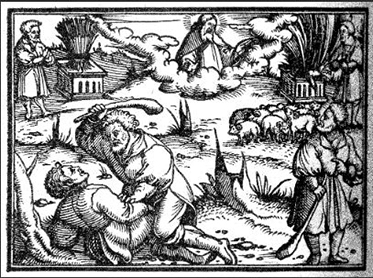In the book of Genesis, after Cain kills Abel, God curses Cain to a life of toil and wandering. But when Cain laments that his own life is in danger, God promises to protect him: “The Lord put a mark on Cain, so that no one who came upon him would kill him” (
What is this mysterious mark? The Hebrew word oth can mean a sign or token of any kind, with nothing to indicate if having such a mark is good or bad. Is it a visible mark on Cain’s body? If so, what and where? Or does it refer to some other kind of distinguishing sign?
Jewish and Christian interpreters have proposed various explanations. The Bible connects the mark with divine protection, but some interpreters link it with the curse that God placed upon Cain, imagining it as a badge of shame. One suggestion in a Jewish midrash, for example, is that Cain was punished with leprosy (Genesis Rabbah XXII.12).
Another interpretation has a disturbing, racist legacy: the idea that the mark of Cain is dark skin. Although nothing in the Bible suggests it is related to skin color, the motif that Cain was cursed with blackness—and that black people are cursed as well—was common from the 18th and into the 20th century. Together with the more common motif that Noah’s son Ham was cursed with black skin and his descendants condemned to slavery (based on
The mark of Cain has also been interpreted in anti-Semitic ways. Some Christian interpreters saw Cain as the prototype of the Jewish people (although according to the biblical genealogy in
But other interpreters read the mark as something protective. The same midrash that mentions leprosy (Genesis Rabbah XXII.12) also suggests a range of other possibilities: for instance, it relates that Cain grew a horn, which is both a mark of identity and a defensive weapon. This same text also speculates that God gave Cain a dog as the “mark.” Though dogs tend to be portrayed negatively in classical Jewish sources, the dog might be a sign both of stigma and of protection from attackers. Other Jewish and Christian writers imagine a visible symbol on Cain’s forehead that communicates he should not be harmed, although his forehead is not mentioned in Genesis.
But the most striking interpretations rely on a later meaning of the Hebrew word oth: a letter of the alphabet. A midrashic text suggests that God inscribed a letter on Cain’s arm as a mark of protection (Pirqe Rabbi Eliezer 21). Thus, the mark of Cain becomes a sacred sign. In another midrash (Tanhuma Genesis 10), it is the word Sabbath that is inscribed on Cain’s face—after the personified Sabbath day itself begged God to forgive Cain’s sin. And a targum—an Aramaic translation of the Hebrew Scriptures—identifies the mark as the holiest sign of all: God inscribes on Cain “the great and honorable name of the LORD,” namely the tetragrammaton, the four-letter name of God (YHWH).
These diverse explanations—from badge of shame to sacred name of God—do not tell us what the text’s original writers intended. But they do reflect the conflicted attitudes that Bible readers, ancient and modern, have had toward Cain himself.
Bibliography
- James, Elaine, and Silviu N. Bunta. “Cain, Mark of.” Pages 743-745 in vol. 4 of The Encyclopedia of the Bible and Its Reception. Edited by H.-J. Klauck et al. Berlin: de Gruyter, 2012.
- Luttikhuizen, Gerard P., ed. Eve’s Children: The Biblical Stories Retold and Interpreted in Jewish and Christian Traditions. Leiden: Brill, 2003.
- Kugel, James L. In Potiphar’s House: The Interpretive Life of Biblical Texts. Cambridge: Harvard University Press, 1994. See especially pp. 159–72.
- Mellinkoff, Ruth. The Mark of Cain. Berkeley: University of California Press, 1981.
- Kugel, James L. Traditions of the Bible: A Guide to the Bible as It Was at the Start of the Common Era. Cambridge: Harvard University Press, 1998. See especially pp. 165, 169.




